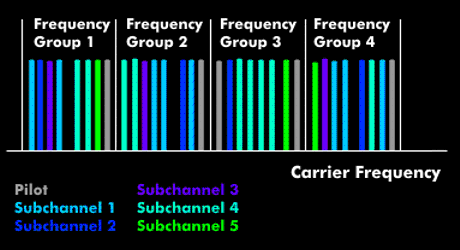orthogonal frequency division multiple access (OFDMA)
Orthogonal Frequency Division Multiple Access (OFDMA) is an access method for radio systems based on Orthogonal Frequency Division Multiplex( OFDM) and extended by Frequency Division Multiple Access( FDMA) and Time Division Multiple Access ( TDMA). This is also the difference to OFDM, which works with one-dimensional multiple access in the form of time slots.
Multiple access methods allow single or multiple orthogonal subcarriers to be assigned to different users. Via the allocated time slots of TDMA and the subchannels of FDMA, the transmission capacity can be adapted to the user requirements. Thus, a subscriber making a phone call is assigned a lower bandwidth than one watching Internet TV.
Subcarrier and channel width
In OFDMA, the transmitter maps the serial bit streams to be transmitted on various subcarriers. The number of subcarriers depends on the channel width. The individual subcarriers are transmitted in parallel over the available bandwidth of the radio channel. The more subchannels are used for transmission, the lower the symbol rate, which is reflected in the frequency changes ofthe transmitted signal. As far as orthogonality is concerned, the ratio of the available bandwidth to the symbol rate is chosen so that the maximum of a subcarrier spectrum lies in the minima of its neighbors.
OFDMA recognizes three different subcarriers: the
- Data subcarrier for data transmission,
- the pilot subcarrier for synchronization and
- the Null Subcarrier without transmission function. These are used to provide the guard zones.
WiMAX and OFDMA
The OFDMA used in WiMAX has a flexible number of carrier frequencies compared to OFDM. Whereas OFDM uses 256, OFDMA can use 128, 512, 1,024 or 2,048. The coding, modulation and amplitude are set separately for each subchannel, depending on the channel conditions. This means that the transmission power can be optimally adapted to different transmission conditions.OFDMA provides for the assignment of the more or less many subcarriers of a radio network to the different Radio Network Terminations( RNT). This function compensates for symbol rate interference and local oscillator( LO) frequency deviations. Since the frequencies of the local oscillators can vary considerably due to aging and temperature, the OFDMA function ensures the reference to a subcarrier.
OFDMA is mainly used in high-speed mobile networks such as 802.16m, Ultra Mobile Broadband( UMB), Long Term Evolution( LTE), WiBro and Mobile-WiMAX.

